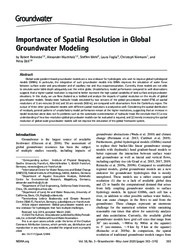Importance of Spatial Resolution in Global Groundwater Modeling
DOI: https://doi.org/10.1111/gwat.12996
Persistent URL: http://resolver.sub.uni-goettingen.de/purl?gldocs-11858/8805
Persistent URL: http://resolver.sub.uni-goettingen.de/purl?gldocs-11858/8805
Reinecke, Robert; Wachholz, Alexander; Mehl, Steffen; Foglia, Laura; Niemann, Christoph; Döll, Petra, 2020: Importance of Spatial Resolution in Global Groundwater Modeling. In: Groundwater, Band 58, 3: 363 - 376, DOI: 10.1111/gwat.12996.
 |
Dokument öffnen: |
Global-scale gradient-based groundwater models are a new endeavor for hydrologists who wish to improve global hydrological models (GHMs). In particular, the integration of such groundwater models into GHMs improves the simulation of water flows between surface water and groundwater and of capillary rise and thus evapotranspiration. Currently, these models are not able to simulate water table depth adequately over the entire globe. Unsatisfactory model performance compared to well observations suggests that a higher spatial resolution is required to better represent the high spatial variability of land surface and groundwater elevations. In this study, we use New Zealand as a testbed and analyze the impacts of spatial resolution on the results of global groundwater models. Steady-state hydraulic heads simulated by two versions of the global groundwater model G3M, at spatial resolutions of 5 arc-minutes (9 km) and 30 arc-seconds (900 m), are compared with observations from the Canterbury region. The output of three other groundwater models with different spatial resolutions is analyzed as well. Considering the spatial distribution of residuals, general patterns of unsatisfactory model performance remain at the higher resolutions, suggesting that an increase in model resolution alone does not fix problems such as the systematic overestimation of hydraulic head. We conclude that (1) a new understanding of how low-resolution global groundwater models can be evaluated is required, and (2) merely increasing the spatial resolution of global-scale groundwater models will not improve the simulation of the global freshwater system.
Statistik:
ZugriffsstatistikSammlung:
- Geographie, Hydrologie [454]
This is an open access article under the terms of the Creative Commons Attribution License, which permits use, distribution and reproduction in any medium, provided the original work is properly cited.

